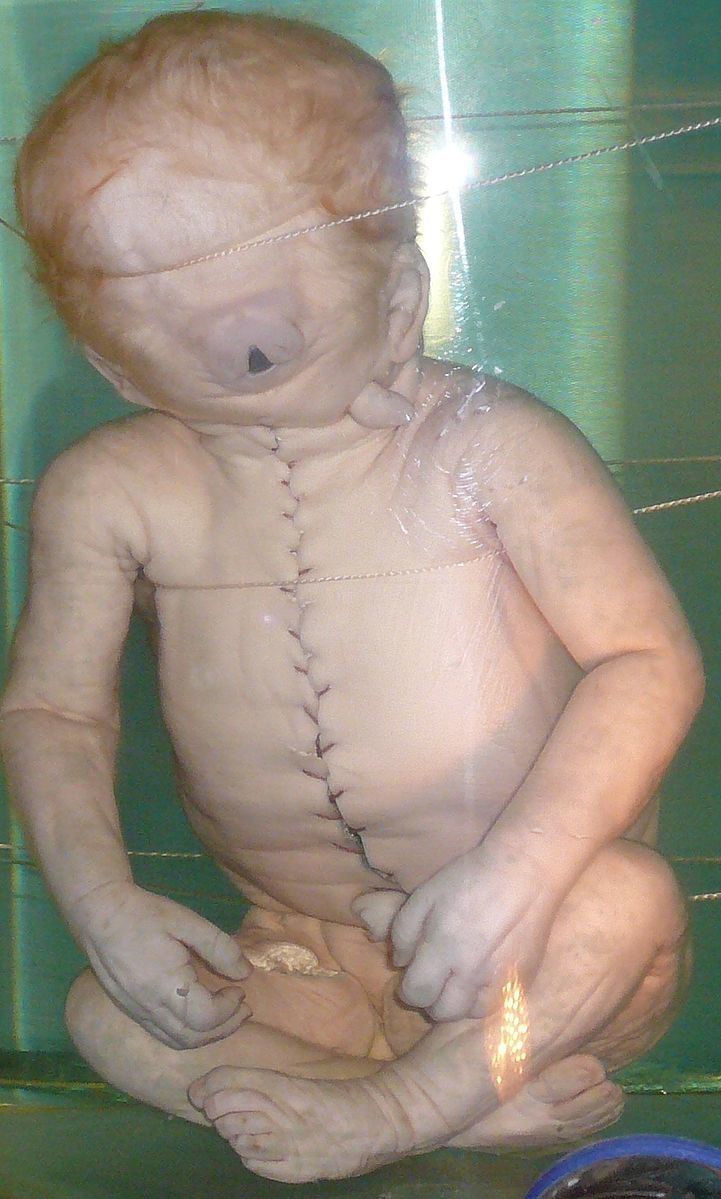Specialty medical genetics ICD-9-CM 759.89 | ICD-10 Q87.0 | |
 | ||
Cyclopia (also cyclocephaly or synophthalmia) is a rare form of holoprosencephaly and is a congenital disorder (birth defect) characterized by the failure of the embryonic prosencephalon to properly divide the orbits of the eye into two cavities. Its incidence is 1 in 16,000 in born animals and 1 in 200 in miscarried fetuses.
Contents
First, That it had no sign of any Nose in the usual place, nor had it any, in any other place of the Head, unless the double Bagg CC that grew out of the midst of the forehead, were some rudiment of it. Next, That the two Eyes were united into one Double Eye which was placed just in the middle of the Brow.
Presentation
Typically, the nose is either missing or replaced with a non-functioning nose in the form of a proboscis. Such a proboscis generally appears above the central eye, or on the back, and is characteristic of a form of cyclopia called rhinencephaly or rhinocephaly. Most such embryos are either naturally aborted or are stillborn upon delivery.
Although cyclopia is rare, several cyclopic human babies are preserved in medical museums (e.g. The Vrolik Museum, Amsterdam).
Some extreme cases of cyclopia have been documented in farm animals (horses, sheep, pigs, and sometimes chickens). In such cases, the nose and mouth fail to form, or the nose grows from the roof of the mouth obstructing airflow, resulting in suffocation shortly after birth.
Causes
Genetic defects or toxins can misdirect the embryonic forebrain-dividing process. One highly teratogenic alkaloid toxin that can cause cyclopia is cyclopamine or 2-deoxyjervine, found in the plant Veratrum californicum (also known as corn lily or false hellebore). Grazing animals are most likely to ingest this plant and induce cyclopia in offspring. The mistake of humans ingesting Veratrum californicum while pregnant is often due to hellebore, an unrelated plant with the same name, being recommended as a "natural" treatment for vomiting, cramps, and poor circulation, three conditions which may be present in the early stages of pregnancy. Cyclopia occurs when certain proteins are inappropriately expressed, causing the brain to stay whole, rather than developing two distinct hemispheres. This leads to the fetus having one optic lobe and one olfactory lobe, resulting in the eye and nose malformations of cyclopia.
The sonic hedgehog (SHH) gene regulator is involved in the separation of the single eye field into two bilateral fields. Although not proven, it is thought that SHH emitted from the prechordal plate suppresses Pax6, which causes the eye field to divide into two. If the SHH gene is mutated, the result is cyclopia, a single eye in the center of the face (Gilbert, 2000).
Notable cases
First, That it had no sign of any Nose in the usual place, nor had it any, in any other place of the Head, unless the double Bagg CC that grew out of the midst of the forehead, were some rudiment of it. Next, That the two Eyes were united into one Double Eye which was placed just in the middle of the Brow.
